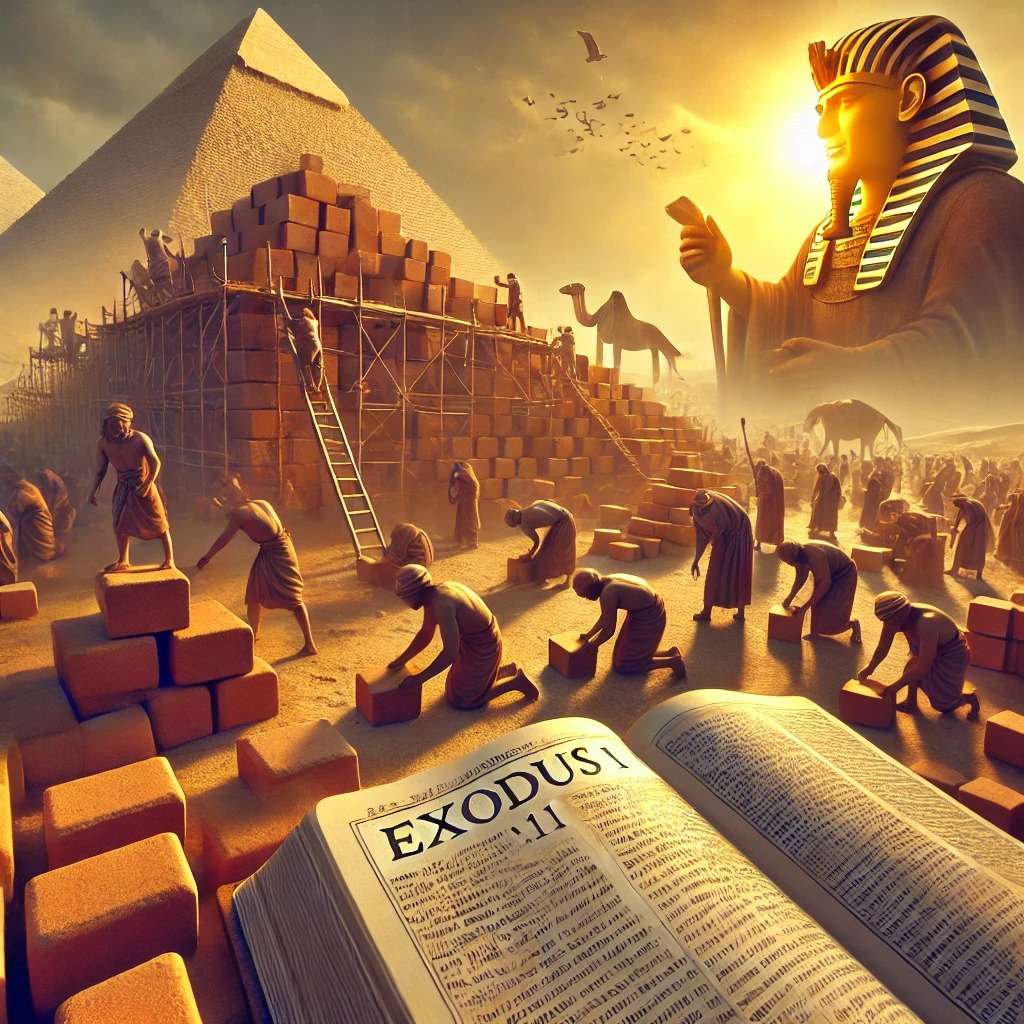
When you dive into Exodus 1 KJV, you’re stepping into a pivotal moment in biblical history. This chapter sets the stage for the dramatic story of the Israelites’ bondage in Egypt and their eventual liberation. The King James Version brings this ancient narrative to life with its timeless language and rich detail.
Whether you’re studying for spiritual growth or academic interest, understanding Exodus 1 KJV offers profound insights into themes of oppression, resilience, and divine intervention. You’ll find yourself captivated by the struggles and triumphs of a people whose faith carried them through unimaginable hardships.
Overview of Exodus 1 KJV
Exodus 1 in the King James Version (KJV) describes the initial plight of the Israelites in Egypt. The chapter begins with a list of Jacob’s descendants who came to Egypt, totaling seventy souls. Joseph and his brothers die, leading to a new era where the Israelites prosper and multiply.
A new Pharaoh, who doesn’t know Joseph, rises to power. He feels threatened by the Israelites’ growing numbers and strength. To curb this perceived threat, he imposes harsh labor on them, forcing them into brutal servitude building store cities like Pithom and Raamses.
Despite their suffering, the Israelites continue to grow in number. Frustrated by this resilience, Pharaoh orders Hebrew midwives Shiphrah and Puah to kill all newborn Hebrew boys during childbirth. The midwives fear God more than Pharaoh; they disobey his order and allow the boys to live.
Pharaoh then commands all Egyptians to throw every newborn Hebrew boy into the Nile River while sparing girls. This decree marks an escalation in oppression against the Israelites.
This chapter sets up key themes—oppression under Egyptian rule, divine protection through faithful individuals like Shiphrah and Puah, and increasing tension between Israelite growth and Egyptian authority—that will unfold throughout Exodus.
Historical Context
Understanding the historical context of Exodus 1 in the King James Version (KJV) helps you grasp its significance and depth.
Biblical Timeline
Exodus 1 is situated after Genesis, continuing the narrative of the Israelites. Approximately 400 years have passed since Joseph brought his family to Egypt (Genesis 46:27). This period marks a significant shift from prosperity to oppression for the Israelites. The timeline covers their growth as a nation and sets up events leading to Moses’ birth and eventual liberation efforts.
Egyptian Setting
The setting takes place in ancient Egypt, where Pharaohs ruled with absolute power. A new Pharaoh, who didn’t know Joseph, rose to power around 1550-1292 BC. Fearing Israelite numbers might threaten his rule or ally with enemies, he imposed severe labor conditions on them. The Egyptian environment included grand architecture like pyramids and temples built by enslaved people under harsh conditions, mirroring the Israelites’ experiences described in Exodus 1.
Key Themes in Exodus 1 KJV
Exodus 1 KJV delves into several profound themes. The chapter not only sets the stage for the Israelites’ suffering but also highlights their resilience and divine protection.
Oppression of Israelites
Pharaoh’s fear of the growing Israelite population leads to severe oppression. He imposes hard labor, enslaving them to build monumental structures like Pithom and Raamses (Exodus 1:11). Despite these harsh conditions, the Israelites thrive, multiplying even under extreme duress. Pharaoh’s increasing paranoia results in a decree to kill newborn Hebrew boys (Exodus 1:16), intending to curb their numbers. This oppressive environment showcases both Egyptian cruelty and Israelite tenacity.
Birth and Preservation of Moses
Against this backdrop of oppression, Moses’ birth marks a pivotal moment. His mother Jochebed hides him for three months to protect him from Pharaoh’s edict (Exodus 2:2). When concealment becomes impossible, she places him in an ark made of bulrushes on the Nile River (Exodus 2:3). Pharaoh’s daughter discovers Moses, adopting him despite his Hebrew origins (Exodus 2:5-6). This act of preservation signifies divine intervention amidst relentless persecution.
Literary Analysis
Exodus 1 KJV uses various literary techniques to convey its themes and messages. The chapter’s structure, style, language, and imagery work together to create a powerful narrative.
Structure and Style
The structure of Exodus 1 is linear. It starts with the Israelites’ prosperity in Egypt and moves through their increasing oppression under a new Pharaoh. This progression highlights the escalating tension between the Egyptians and Israelites. The style is narrative, using direct speech for dialogue between characters such as Pharaoh and the midwives.
Sentence length varies to maintain reader engagement. Short sentences emphasize key actions or commands, like Pharaoh’s decree: “Every son that is born ye shall cast into the river.” Longer sentences provide details about circumstances or events, adding depth to the story.
Language and Imagery
The language in Exodus 1 KJV is formal yet accessible. Key terms like “oppression,” “multiplication,” and “midwives” recur throughout the chapter to reinforce central themes. The use of repetition underscores important points; for example, repeating phrases about Israelite growth stresses their resilience despite adversity.
Imagery plays a crucial role in depicting suffering and divine protection. Visual descriptions include harsh labor scenes (“made their lives bitter with hard bondage”) contrasted with moments of hope (the midwives’ defiance). Metaphors are sparse but effective; comparing Israel’s growth to swarms suggests both abundance and threat from an Egyptian perspective.
These literary elements combine seamlessly to enhance your understanding of Exodus 1 KJV’s profound messages on oppression, resilience, and divine intervention.
Theological Significance
Exodus 1 KJV offers profound insights into the relationship between God and His people, highlighting themes of covenant and redemption.
Covenant with God
The book of Exodus underscores the foundational covenant between God and the Israelites. This chapter marks a continuation of God’s promises to Abraham, Isaac, and Jacob. You see that despite their suffering in Egypt, the Israelites remain God’s chosen people. Their increasing numbers fulfill God’s promise to make them a great nation (Genesis 12:2). By preserving Hebrew boys through midwives like Shiphrah and Puah, divine protection is evident even under dire circumstances.
Deliverance and Redemption
Deliverance from bondage is another central theme in Exodus 1. The narrative sets up the need for divine intervention by detailing the oppressive conditions faced by the Israelites. Pharaoh’s decree to kill Hebrew boys signifies extreme measures taken against them. However, you’ll notice that these actions foreshadow God’s ultimate plan for redemption through Moses’ birth and leadership later in Exodus. This chapter emphasizes that deliverance often requires faith amid adversity, as seen through acts of bravery by individuals defying unjust commands.
This section connects key theological concepts within Exodus 1 KJV—covenant with God highlights enduring promises while deliverance and redemption illustrate divine rescue from oppression.
Conclusion:
Exodus 1 KJV
Exodus 1 KJV presents a powerful narrative of oppression and divine intervention, setting the stage for the Israelites’ deliverance from bondage. This chapter not only highlights human resilience but also underscores God’s unwavering covenant and protection. As you reflect on these themes, remember the enduring promises and divine rescue that offer hope even in the darkest times. The faith displayed by key figures like Shiphrah and Puah serves as a testament to trusting in divine plans amidst adversity. Exodus 1 KJV remains a timeless reminder of redemption, faith, and God’s commitment to His people.
Frequently Asked Questions:
Exodus 1 KJV
What are the main themes discussed in Exodus 1 KJV?
The main themes in Exodus 1 KJV are oppression, resilience, and divine intervention. The chapter highlights the Israelites’ bondage in Egypt, their harsh labor conditions, and God’s protection leading to their eventual liberation.
Who are Shiphrah and Puah in Exodus 1 KJV?
Shiphrah and Puah are Hebrew midwives mentioned in Exodus 1 KJV. They played crucial roles in protecting Hebrew boys from Pharaoh’s decree to kill them, showcasing God’s divine protection.
How does Exodus 1 KJV emphasize the covenant between God and the Israelites?
Exodus 1 KJV underscores the foundational covenant between God and the Israelites by continuing His promises to Abraham, Isaac, and Jacob. It highlights divine protection even under harsh circumstances as part of this enduring promise.
What theological significance is explored in Exodus 1 KJV?
The theological significance explored includes themes of covenant and redemption. The chapter emphasizes deliverance from bondage through divine intervention and showcases faith amid adversity as central to experiencing God’s rescue.
Why is faith important according to Exodus 1 KJV?
Faith is important according to Exodus 1 KJV because it plays a crucial role in experiencing deliverance from oppression. The chapter illustrates that trusting in God’s promises can lead to miraculous rescue even during dire circumstances.
How does Pharaoh’s decree affect the Israelites?
Pharaoh’s decree to kill all newborn Hebrew boys intensifies the oppression faced by the Israelites. It represents an attempt to curb their growth but ultimately leads to greater acts of resilience and divine intervention.
What connection does Exodus 1 have with other parts of the Bible?
Exodus 1 connects with other parts of the Bible through its continuation of God’s promises made to patriarchs like Abraham, Isaac, and Jacob. It sets the stage for subsequent acts of deliverance detailed throughout biblical narratives.

